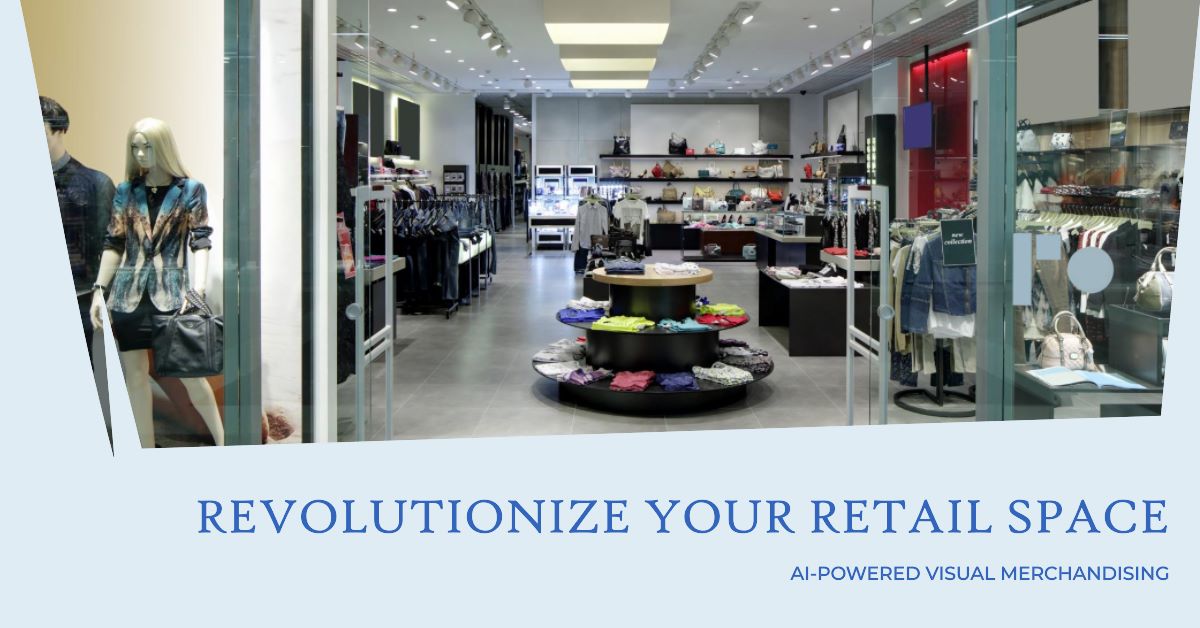
AI-Powered Visual Merchandising: A New Era in Retail
Customer Behavior Analysis:
AI can analyze in-store video footage to understand customer behavior, track their movements, and identify which displays attract the most attention.
This data can then be used to optimize store layouts and product placements.
Virtual Try-Ons:
Augmented Reality (AR) powered by AI can allow customers to virtually try on clothes, accessories, or makeup without physically wearing them.
This can enhance the shopping experience and reduce the need for fitting rooms.
Personalized Recommendations:
AI can analyze a customer’s past purchases, browsing history, and preferences to provide personalized product recommendations on digital displays as they shop in-store.
Automated Inventory Management:
AI can predict which items will be in demand based on historical data, current trends, and other external factors.
This can help retailers stock up on popular items and create displays that highlight them.
Dynamic Pricing:
AI can analyze real-time data on inventory levels, demand, and competitor pricing to automatically adjust prices on digital price tags.
Interactive Displays:
AI-powered displays can interact with customers, answer questions, provide additional product information, or even suggest complementary products.
Optimized Store Layouts:
By analyzing customer flow and behavior, AI can suggest optimal store layouts that maximize sales and improve the shopping experience.
Trend Forecasting:
AI can analyze social media, online searches, and other data sources to predict upcoming fashion and product trends.
Retailers can then adjust their visual merchandising strategies accordingly.
Chatbots and Virtual Assistants:
In larger stores, AI-powered chatbots or virtual assistants can guide customers to specific products or sections, answer queries, and provide additional information.
Feedback Analysis:
AI can analyze customer feedback from various sources, including online reviews, social media, and in-store feedback systems, to identify areas of improvement in visual merchandising.
Digital Signage Content Optimization:
AI can determine which content on digital signs is most effective in terms of customer engagement and sales, and then optimize the content accordingly.
Enhanced Customer Engagement:
AI can be used to create gamified experiences in-store, where customers can engage in AR games or challenges related to products, earning discounts or rewards.
Safety and Compliance:
AI can monitor in-store displays to ensure they comply with safety standards and regulations. If a potential hazard is detected, alerts can be sent to staff.
Sustainability:
AI can help retailers understand the environmental impact of their visual merchandising materials and suggest more sustainable alternatives.
Incorporating AI into visual merchandising requires an initial investment in technology and training.
However, the potential benefits in terms of increased sales, enhanced customer experience, and operational efficiencies can offer a significant return on investment.
As with any technology, it’s essential to keep the customer’s privacy in mind and ensure that any data collected is used ethically and responsibly.
Example: Money Mapping in Visual Merchandising
What is Money Mapping?
Money Mapping is a technique used to measure the sales performance of a store based on its layout and design.
Retailers map out the sales floor with the exact location of products and then break the map of the store into ‘zones’, typically around certain fixtures, shelves, and displays.
These zones can consist of several different items, grouped by either category or style.
Retailers then collate the sales of every item in this zone and compare it to others in the same store.
This gives an impression of shop floor sales broken down by areas of the store, allowing retailers to visualize and analyze which areas are ‘hotspots’ for sales and which are ‘cold’.
Benefits of Money Mapping:
- Provides insights into the consumer experience.
- Offers valuable data for visual merchandisers.
- Breaks down areas of the sales floor by sales performance.
- Can be used to optimize store layout.
- Drives sales by comparing product placement & visual merchandising.
- Enables A/B testing for product combinations and store layouts.
How AI Enhances Money Mapping:
Traditionally, the process of matching sales data to specific locations on the sales floor for every item and store was logistically challenging.
However, with the advent of AI, this process has been simplified.
Using RFID (Radio Frequency Identification) and AI localization techniques, retailers can now create a map of a store as part of the daily or weekly stock count.
This is achieved by adding ‘reference’ RFID tags into the store on fixtures and walls.
These tags, combined with the signal strength from stock counts, help map exactly where items are in the store.
This location information, when integrated with point-of-sale data, generates an automated Money Map of a store.
With this automated data collection, visual merchandisers can focus on optimizing product placement and store design.
Process for AI Money Mapping:
- Attach reference RFID tags to walls and fixtures within the store.
- Perform regular RFID stock takes.
- Use machine learning to map out item locations within the store.
- Integrate point of sale data with RFID software.
- Produce a ‘heat map’ of the store based on sales.
- Visual merchandisers can then use this data to inform strategy and measure results.
AI-enabled Money Mapping provides retailers with unprecedented insights into the sales distribution of the shop floor.
By utilizing RFID tags and Machine Learning, it’s possible to map out the location of items in a store and understand which areas are ‘hotspots’ for sales and which are underperforming.
This data empowers visual merchandisers to focus on improving the design or layout of specific areas, leveraging sales hotspots, and optimizing product placements.
Example: Predictive Merchandising and Visual Intelligence
What is Predictive Merchandising?
Predictive merchandising refers to the application of data science techniques to accurately predict outcomes that address business challenges in retail.
This can encompass product recommendations and inventory management.
Accurate product recommendations can enhance customer relationships, leading to increased sales and customer retention.
Predictive insights also help in determining optimal stock levels, preventing overstocking (which can lead to discount sales) or understocking (where customers might turn to other retailers).
How is Predictive Merchandising Powered?
Traditionally, predictive merchandising has been powered by online tracking tags.
These tags capture and analyze key information at each stage of the shopping process.
For instance, if you’ve ever added an item to your online cart and later received an email showcasing the same item or offering a discount, that’s predictive merchandising in action.
These tags track visitor behavior, and the data is then analyzed to automate subsequent steps, nudging consumers towards making purchases or suggesting similar products.
Challenges with Traditional Predictive Merchandising:
Consumer shopping behaviors have evolved. They no longer follow a linear path to purchase, making it challenging to predict their shopping journey.
With inspiration coming from various sources like social media, content aggregators, and traditional media, it’s become harder for retailers to gather the necessary data to predict customer interests effectively.
Power of Visual Intelligence in Predictive Merchandising:
Visual intelligence, powered by AI, is transforming the way retailers understand and engage with consumers.
Social media, a significant catalyst for shopping inspiration, allows retailers to leverage images to discern individual interests and foster stronger engagement.
AI-driven visual intelligence enables retailers to extract insights from images, allowing consumers to directly purchase products showcased in those images.
By integrating predictive merchandising with visual intelligence, retailers can crowdsource consumer reactions, understand trends, and make more informed predictions for merchandising.
AI technology is significantly impacting the retail industry.
It’s enabling retailers to customize consumer experiences based on authentic user data while also helping them manage their inventories responsibly.
By harnessing the insights from visual intelligence, brands can refine their predictive merchandising strategies, making product recommendations even more accurate and appealing to consumers.
Considerations for Effective Use of AI in VM
1. Data Creation and Labeling
- Problem: Inaccurate and inconsistent data can lead to AI making poor decisions.
- Solution: AI can help in creating rich metadata for each product, eliminating human errors. This is achieved using Computer Vision algorithms which can automatically identify various attributes of a product and tag them. The same algorithm can also be used to generate titles and descriptions for the product, resulting in SEO-ready rich metadata which is easily searchable.
- Impact: Reliable, SEO-ready tags, titles, and descriptions can boost product discoverability on search engines. Automated product tagging provides more accurate attributes for products, leading to better search results.
2. Data Structuring and Transformation
- Problem: Inconsistent data across products, product types, and brands.
- Solution: AI can be used to structure and transform data from a semi-structured or an unstructured format to the one used by the marketplace. Algorithms can identify and transform attributes from tables of data or even paragraphs of text.
- Impact: This helps in cleaning up, grouping, categorizing, searching, sorting, and filtering data on the marketplace.
3. Data Insights to Drive Better Decisions
- Problem: Traditional analytics cannot be used to automate decision-making engines.
- Solution: With AI, retailers can create data models to derive insights and build prescriptive or predictive decision engines. This can help retailers with things like demand forecasting.
- Impact: Over time, these predictive models can learn to make better decisions, allowing retailers to accurately forecast trends.
4. Product Discovery
- Problem: Relevance of search results to individual users.
- Solution: AI-powered site search can help tailor search results by boosting specific affinities for each shopper. Each click can be used to learn about the shopper’s preferences.
- Impact: Enhanced product discovery tailored to individual preferences.
5. Real-time Personalization of the Shopper Journey
- Problem: Brands need to understand the visual preferences and style of each shopper.
- Solution: With real-time personalization, retailers can understand shopper intent with each click and serve personalized product recommendations.
- Impact: Increased engagement and more personalized shopping experiences.
6. Personalized Curation
- Problem: Shoppers are looking for unique collections curated specifically for them.
- Solution: An AI styling assistant can curate looks, mood boards, outfits, and collections for each shopper based on their visual style preferences.
- Impact: Increased number of items in the cart and enhanced shopping experience.
7. Cart Abandonment Emails
- Problem: High rates of shopping cart abandonment.
- Solution: An AI-powered cart recovery tool can recommend visually similar products and styling suggestions personalized for each shopper, making cart abandonment emails more compelling.
- Impact: Increased chances of recovering abandoned carts and enhancing the shopper’s connection with the retailer.
AI in Retail can significantly improve efficiencies across workflows.
Automation processes help brands with accurate data creation and provide context around shoppers’ needs and behaviors.
By accessing this accurate data and using it across personalization, styling, and customized marketing, brands can curate experiences that are meaningful to the shopper. Intelligent retail automation leverages the power of data, and the amount of data that needs to be processed from even a single shopper makes automation a necessity.
Retailers today need automation to capture data across touchpoints and channels and also need to unify this data to provide a seamless shopping experience.
AI’s Impact on Visual Merchandising Design
-
Data-Driven Insights:
- Description: AI enables visual merchandisers to harness vast amounts of customer data, providing insights into consumer behavior. This data-driven approach allows for the curation of displays and product arrangements that maximize engagement and sales.
- Impact: AI-powered analytics can determine optimal product placements, highlight popular items, and even predict future trends, giving brands a competitive edge.
-
Personalization and Targeted Marketing:
- Description: AI empowers brands to deliver personalized experiences to individual customers. By analyzing customer data, AI can tailor visual merchandising displays and create targeted marketing campaigns.
- Impact: AI algorithms can dynamically adapt visual merchandising strategies in real-time, ensuring that customers are presented with relevant products and promotions based on their unique preferences and purchasing history.
-
Virtual and Augmented Reality Experiences:
- Description: AI-powered technologies such as virtual reality (VR) and augmented reality (AR) are revolutionizing the way customers interact with products. These technologies create immersive and interactive experiences.
- Impact: AI algorithms enhance the realism and interactivity of VR and AR environments, allowing customers to visualize products in their intended contexts. This enables brands to showcase a wider range of products in limited physical spaces and provides a more engaging shopping experience.
-
Automated Visual Merchandising:
- Description: AI is automating many aspects of visual merchandising design. Computer vision algorithms can analyze images and videos to identify product attributes, detect trends, and generate data-driven recommendations.
- Impact: This automation reduces manual effort, allowing visual merchandisers to focus on more strategic and creative tasks. Brands can experiment and optimize their displays before implementation.
-
Seamless Omnichannel Experiences:
- Description: AI facilitates integration across various retail channels, ensuring consistent branding, product positioning, and messaging across platforms.
- Impact: This integration provides customers with a cohesive and immersive brand experience regardless of their chosen platform, helping brands build brand loyalty and increase customer engagement.
-
Continuous Optimization and Adaptation:
- Description: AI enables real-time monitoring and optimization of visual merchandising efforts. Brands can gather feedback and performance metrics on visual merchandising displays, enabling them to make data-driven adjustments.
- Impact: AI algorithms can identify underperforming areas, recommend changes, and test different variations to optimize visual merchandising designs continuously.
Artificial intelligence is revolutionizing the field of visual merchandising design.
By harnessing the power of AI, brands can optimize their displays, deliver personalized content, and create seamless omnichannel experiences that resonate with customers.
As AI continues to evolve, it offers unprecedented opportunities for brands to create engaging, personalized, and data-driven experiences.
Creating Irresistible Retail Spaces with Generative AI
-
Understanding Shopper Behavior:
- Description: Generative AI algorithms analyze vast amounts of data to derive insights into shopper behavior. By examining footfall patterns and sales data, these algorithms can identify correlations and patterns, helping retailers understand customer preferences and the most frequently visited store areas.
- Impact: With this knowledge, retailers can strategically place high-demand products in prime locations and allocate space according to customer traffic, enhancing the overall shopping experience.
-
Optimizing Store Layouts:
- Description: AI algorithms generate optimized store layouts designed to maximize customer engagement and drive sales. By simulating different merchandising strategies, generative AI allows retailers to visualize the impact of various product placements and display techniques.
- Impact: Retailers can make informed decisions about store layouts, ensuring effective utilization of every inch of retail space.
-
Benefits of AI-Driven Visual Merchandising:
- Description: Generative AI offers numerous benefits, including identifying product adjacency opportunities, optimizing product sequencing, and determining the optimal product assortment and placement based on factors like product popularity, seasonality, and customer preferences.
- Impact: This results in increased cross-selling, impulse buying, and revenue. The arrangement of items in a logical and visually appealing manner captures shoppers’ attention, encouraging them to explore the entire store.
-
The Results:
- Description: The integration of generative AI into visual merchandising has led to significant improvements in sales, with increases ranging from 15% to 20%. AI-driven store layouts captivate customers, enticing them to spend more time exploring products.
- Impact: The personalized approach facilitated by AI algorithms enhances customer satisfaction by offering tailored shopping experiences.
-
The Future of AI in Retail:
- Description: The potential of AI in the retail industry continues to grow with advancements in technologies like computer vision and augmented reality (AR). The future may see AI-powered virtual reality (VR) simulations allowing customers to virtually navigate through a store and interact with products before purchasing.
- Impact: Such innovations can reshape the retail landscape, merging the boundaries between physical and digital experiences.
Generative AI is proving to be a game-changer in the retail industry, optimizing visual merchandising and store layouts.
By creating immersive and engaging shopping environments, AI-driven strategies are leading to increased sales and improved customer satisfaction.
As technology continues to evolve, the potential for AI to further revolutionize the retail landscape is immense.
More About Visual Merchandising (Further Reading):
Visual Merchandising Fundamentals
Importance of Signage in Visual Merchandising
The Art of Visual Merchandising for Pool Supply Stores



















